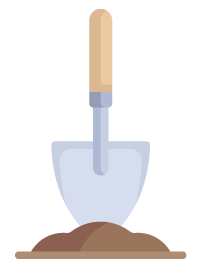 Keeping Camellias and Rhododendrons in pots
Keeping Camellias and Rhododendrons in pots
When You Bring Your Plants Home
We grow our plants in our own formulation of premium potting media. Plants from us will last many months in their existing pot if required provided they are regularly watered and positioned out of extremes of hot and cold. Place the plants where they get some sun (preferably morning sun), where they will not blow over and where they can drain freely when watered. During prolonged hot weather they should be watered daily. Adjust your watering to reflect the prevailing weather conditions.
Potting Up At Home
The best soil PH for camellias and rhododendrons is around 5.5 – 6.5 (acidic). They enjoy a free draining quality potting mix. Try to purchase one specifically labelled for acid loving plants, if this is not available choose a premium general potting mix and make sure it drains well. (Please read all safety instructions on the packaging before opening) When choosing a pot make sure it has multiple drain holes to avoid water logging and ensure that it is not too large in volume for the plant you have purchased. As a guide try to make sure the diameter of the new pot (the width of the pot across the top) is not more than 10 – 13cm more than the pot you have bought. For example, if you purchase plants in a 20cm pot only move up to a 25cm to 33cm size. If your desired pot is larger, use a plastic pot of the appropriate size and slip this inside your finished pot for the first year and then repot into the finished pot the following year. Place your re-potted plant in a position as recommended for that variety ensuring the plant receives adequate water, sunlight etc. Remember that for best results plants should be re-potted at least every 2nd year.
 Planting Camellias & Rhododendrons
Planting Camellias & Rhododendrons
Preparation
Camellias and Rhododendrons can be planted at any time of year - but a lot of extra care is required if planting in the Summer months. We recommend planting in Autumn and Spring for best results. It is always best to avoid the extremes of weather if possible. Whatever time you plant please follow these few basic principles for best results.
Firstly, assess the location, where possible follow the guidelines on the label as each variety will perform best in its preferred amount of sun or shade. Follow the spacing guidelines we have outlined for each variety to achieve the best long-term results. Try to avoid extreme locations for example hot and windy, cold and dark etc.
Camellias particularly make great hedges or boundary fences just ensure there is enough room for them to grow and or be pruned for the desired effect.
When planting camellias and rhododendrons in the ground you first need to make sure that the soil conditions are suitable. If you already have other acid loving plants in your garden (camellias, rhododendrons, azaleas, hydrangeas, gardenias etc) that are doing well, you are right proceed.
If you are unsure a simple soil ph test kit available from garden/ hardware stores will allow you to determine your readiness to plant. Camellias and rhododendrons will do well in the ground if the ph is 5 – 6.5, a soil test that registers a ph below 5 indicates that lime needs to be added. We recommend dolomite lime as it acts more gently than garden lime. If the ph is above 6.5 the addition of aluminium sulphate (often sold as “hydrangea blueing tonic) will help reduce the acidity. In either case dig over the area to be planted, apply the recommend quantity of the product (normally described as an amount per m2), and water in well. At the same time, the addition of well-rotted compost or cow manure will also be beneficial for drainage and nutrient.
If the ph is within a satisfactory range, the second most important factor is drainage. Dig a hole in the planting area and fill it with water, if the water drains away slowly and steadily the drainage is most likely fine. If the water disappears as you apply it, you may want to and more organic matter to retain moisture but if the water does not drain away much or at all you will need to provide better drainage or plant in a different location. Improving drainage may involve things like digging the area deeper, raising the garden bed higher, providing subsurface drainage using coarse gravels and poly drainage pipes and/or the addition of clay breaker type materials before planting.
JUST REMEMBER THE BETTER THE PREPARATION THE BETTER THE END RESULT!
 Planting
Planting
Once you have prepared your soil, place the potted plants on top of the soil in their desired location. It’s now time to step back and assess the precise positioning based on the aesthetics you are trying to achieve. Try and look from different angles where possible and try to imagine the plant when it has achieved a more mature size. Do not forget to assess the amount of sun/shade etc and the plants proximity to paths, driveways and other plants. When you are satisfied it’s time to plant!
Dig your holes at least twice the width and slightly deeper than the pot, you can add some more compost/ planting mix to the hole at this time if you wish. Remove the plant from its pot and lightly tease a small amount of the potting mix from the base and sides of the root ball without breaking any roots. Place the root ball in the hole and a just the soil height if necessary so that the of the top of the root ball is level with the finished soil level in your garden bed.
DO NOT BURY CAMELLIAS OR RHODODENDRONS TOO DEEP, this can lead to root rot and premature death!! Bacfill the hole with the surrounding soil and firm down gently. Water the plant in and recheck that the root ball is still level with the finished soil level, adjust as required. Mulching around the plants at this time will greatly benefit their long term success, choose a mulch suitable for acid loving plants like composted pine bark etc. Place the mulch around the plant to around 50mm deep but reduce this level around the trunk to just a thin covering, thick mulch against trunks can lead to rot or disease.
 Pests
Pests
There are very few pests that effect camellias. As with many plants, aphids feast near new growth and buds. Mites can also be a problem. Both can be removed by thoroughly hosing the foliage of the plant on a regular basis. Several low and non-toxic sprays are now available for sucking insects from your garden centre. Always seek advice as to what works best in your local area. It is a good idea to take a sample of any affected foliage in a sealed plastic bag to your local garden centre if you are unsure.
 Diseases
Diseases
Camellias and rhododendrons can be affected by root diseases which can mostly be avoided by making sure that your plant is well drained and following the care instructions below.
 Camellia Care
Camellia Care
Camellias and rhododendrons require very little water once established, usually around one water per week while the plant is establishing and once a week when there is a lack of rain. Adjusting watering to the prevailing weather conditions and maintaining a good layer of mulch during the hotter months will reduce water requirements.
Camellias and rhododendrons require minimal fertilising, an application of a specialist camellia and azalea food in spring and autumn is generally all that is required, a good general-purpose fertiliser containing blood and bone can also be used. It is best to follow the fertiliser instructions on the packet as to the quantities to apply.
Pruning to shape is generally best carried out after flowering in spring, rhododendrons can have their finished flowers removed after flower if desired. Plants can be left unpruned in non-hedging situations. For hedges and screening pruning will improve density and fullness. A second prune for shape in late summer only when the extreme heat has passed can keep formal hedges tidy but be aware you will sacrifice some autumn and winter flowers as a result. Any heavy pruning should be restricted to spring if possible.

